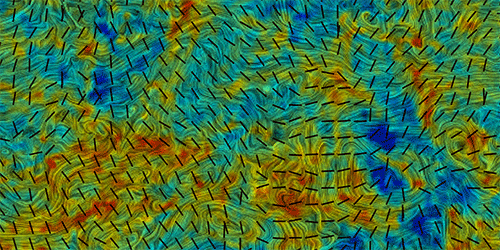A Closer Look at Cosmic Dust
The theory of inflation postulates a brief period of rapid cosmic expansion in the moments following the big bang. One of the theory’s predictions is that the expansion produced gravitational waves, which imprinted a faint polarization on the cosmic microwave background (CMB). Several experiments are searching for this signature, but they must first account for similarly polarized radiation from the emission of interstellar dust particles. A numerical study by Alexei Kritsuk and Raphael Flauger of the University of California, San Diego, and the late Sergey Ustyugov, formerly of the Keldysh Institute for Applied Mathematics in Moscow, now shows how turbulence of interstellar magnetic fields in the Milky Way affects dust’s contribution to CMB data.
The polarization of the CMB can be separated into two components, called the E mode and the B mode. Inflationary gravitational waves cause B-mode polarization, which swirls around like an eddy. But dust grains in the Milky Way emit the same form of polarized light when they align in interstellar magnetic fields. Much to their disappointment, researchers realized that dust emission was the source of a tantalizing B-mode signal detected by the BICEP2 telescope in 2014 (see 9 March 2015 Viewpoint).
The study from Kritsuk and collaborators is part of an ongoing effort to more fully understand how dust affects the appearance of the CMB. The team used existing magnetohydrodynamic simulations of interstellar turbulence to synthesize maps of the polarized emission from dust grains. They found that the dust alone could produce a ratio of E-mode to B-mode intensity that roughly matches the ratio seen in observations of the CMB by the Planck satellite. By clarifying the role of interstellar dust, these and other simulations should help researchers design more sensitive searches for B-mode polarized radiation in the CMB.
This research is published in Physical Review Letters.
–Christopher Crockett
Christopher Crockett is a freelance writer based in Arlington, Virginia.





